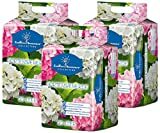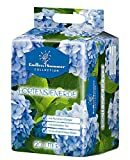Here you can find out everything you need to know about caring for and cutting hydrangeas in pots and beds. We also show our expert tips on choosing a variety.
The genus of hydrangeas (Hydrangea) includes over 70 different species, most of which originally come from East Asian areas. All species are woody plants that can grow in different ways - for example as a shrub or they climb lofty heights. Here you can find out everything about hydrangeas.
The flowers of the hydrangea are usually arranged in panicles or umbel-like inflorescences. The apparent, larger flowers, which make up the actual ornamental value, are only so-called pseudo-flowers. The real flowers, which contribute to seed development, are hidden inside the inflorescences and are not visible at first glance. In the following, we want to take a closer look at the hydrangea and introduce you to everything that is important, from choosing the variety to planting and caring for the hydrangea.
contents
- Hydrangea species and varieties
-
Planting hydrangeas
- Plant hydrangeas in the bed
- Plant hydrangeas in a pot
- Hydrangeas on the balcony
-
Maintain hydrangeas
- Water hydrangeas
- Fertilize hydrangeas
- Cut hydrangeas
- Hibernate hydrangeas
- Propagate hydrangeas
- Pests and diseases on hydrangeas
- Hydrangea flowering period: what to do if the hydrangea does not bloom
- Drying hydrangeas
- Are hydrangeas friendly to bees?
- Is the hydrangea poisonous?
Hydrangea species and varieties
All relevant species are deciduous shrubs, which means that they are leafy in summer and shed their leaves in winter. The star among the hydrangeas is the species originally from Japan Hydrangea macrophylla - even better than Farm hydrangea known. Their characteristic inflorescences are either spherical, but can also be flat like a plate and less heavily peppered with the large ornamental flowers. In addition to the farmer's hydrangea, there is also the Panicle hydrangea (Hydrangea paniculata) and the snowball hydrangea (Hydrangea arborescens) very popular. If you want to rely not only on beautiful flowers, but also on special foliage, you can go to the Oak leaf hydrangeas (Hydrangea quercifolia) precisely. In addition to the so-called Velvet hydrangea (Hydrangea sargentiana), whose name comes from their soft leaves, also exist Climbing hydrangeas (Hydrangea petiolaris) and Japanese tea hydrangeas (Hydrangea serrata).
In this article we will introduce you to the various types mentioned Overview of hydrangea varieties before.

Planting hydrangeas
In the following you will find out which location and which soil conditions the hydrangea needs. We also show the differences between planting hydrangeas in pots and beds.
Plant hydrangeas in the bed
As far as the soil in which the hydrangea is to put its roots is concerned, it has to meet the somewhat special requirements. If the pH value is between 4 and 5, it is optimal. If the hydrangeas are to shine in a strong blue or purple, the pH value of the soil can generally be slightly lower than for pink, red or white hydrangea varieties. If the pH value is a little more alkaline, this does not have any life-threatening effects on it Growth of the hydrangea, however, deficiency symptoms or not the desired color development can occur to lead. In addition to the correct pH value, hydrangeas also need an adequate water supply, otherwise drought damage can quickly occur. It is therefore an advantage to choose a location where the soil has good water storage capabilities. However, the subsoil must not be prone to waterlogging, as this could quickly lead to root rot and the hydrangea to die.

Once the right location has been found, you should first think through the next steps. In soils with a pH that is too high, digging a slightly larger hole can be a good idea. There is space for some substrate with a suitable pH value, such as rhododendron soil. Before and after planting, the hydrangea should be well watered. The soil around the planting can be loosened up to make it easier for the hydrangea to take root. Under no circumstances should the loosened soil around the hydrangea be compacted with energetic kicks to help it hold in the ground.
Plant hydrangeas in a pot
With regard to the location requirements, it makes no difference whether the hydrangea is planted in a container or in a bed. Especially in the pot, she is happy when her wish for a partially shaded location can be fulfilled. Because when cultivating in a pot, the hydrangea has to be watered more often than is the case in the bed. Therefore, the planter should not be selected too small. Again, it is advisable to use rhododendron soil for planting. For an optimal water supply right from the start, the hydrangea can be immersed in a bucket filled with water before planting. The plant is kept completely under water until no more air bubbles rise. After planting, you should water the hydrangea well again so that the loosened substrate settles and the roots have access to water and nutrients.
More detailed information on the Plants of hydrangeas can be found in our special article.

Hydrangeas on the balcony
If you have planted your hydrangea in a pot, you can also place the decorative plant on the balcony. Since hydrangeas prefer shady locations, an east, west or north balcony is the right choice. If you want to keep your hydrangea on a south-facing balcony, you should shade it in the midday sun and ensure there is adequate water supply.
Maintain hydrangeas
Hydrangeas are reliably blooming classics in the garden - but only with the right care. From watering to fertilizing and cutting, you will learn everything about the correct handling of beautiful hydrangeas. General tips on correct Caring for hydrangeas can also be found here in our special article.
Water hydrangeas
Hydrangeas are thirsty and need regular watering. Especially in hot summer temperatures, hydrangeas in the pot may have to be watered several times a day. Even hydrangeas that are planted in the bed can and should groan because of the lack of water be watered regularly to avoid undesirable drought damage such as dried up leaves and flowers avoid. More detailed information on the Watering hydrangeas can be found in our special article.

Fertilize hydrangeas
Any type of hydrangea can develop into a healthy and vigorously blooming beauty with the right fertilization. In addition, the popular farmer's hydrangeas (Hydrangea macrophylla) laid the foundation for the flower color. This is mainly influenced by the soil pH and, to a lesser extent, by fertilization.
An organic slow release fertilizer should already be incorporated when planting the hydrangea. The slowly released nutrients and the activation of the soil life are a good basis for establishing the new planting at the new location. By the way, hydrangeas are planted either in spring (March - May) or in autumn (October - November). Established hydrangeas are fertilized once a year outdoors, and twice a year in pots because of the smaller substrate volume. Our long-term organic fertilizer is also one of these Plantura organic hydrangea fertilizer. It is based on animal-free raw materials from the food, luxury and animal feed industries as well as mineral ones Components that are also used in organic farming and optimally supplies your hydrangea with all the important ones Nutrients.
More information about the Fertilizing hydrangeas and for detailed instructions, see this article on the subject.
What influence substrate and fertilization on the Flower color of the hydrangea can have and how to get the Even color the flowers blue can, find out here.
Cut hydrangeas
The right cut is essential for beautiful flowers. Hydrangeas can be pruned either in the fall or in the spring. In order to determine the right time, one should first know which type of hydrangea it is. Because farm hydrangeas (Hydrangea macrophylla) and oak leaf hydrangeas (Hydrangea quercifolia) develop their flower systems for the next year in autumn. So they bloom on last year's wood. If you cut back too much here, this can mean the loss of the beautiful flower. Panicle (Hydrangea paniculata) or snowball hydrangeas (Hydrangea arborescens), on the other hand, bloom on so-called annual wood - that is, they form their flowers in the same year in which they bloom. These two popular hydrangeas are among the species that can be pruned back without being disturbed.
Here you will find all the important information about the Pruning your hydrangea.

Hibernate hydrangeas
As a rule, you can rely on all of the Hydrangea species are reasonably hardy. In this case, to some extent means that frost damage is unfortunately quite possible and can also affect the flowering. To avoid this, you should note the following:
- A protected place in partial shade should be chosen when planting.
- Winter protection made of leaves, a jute sack, fir branches or mulch protects the plant. Above all, always cover the outer shoots close to the ground.
- Fertilization with mineral nitrogen is taboo from mid-July. Organic fertilizers can be used well into August.
- The fertilizer used should have a sufficiently high potassium content, as this is essential for frost resistance.
- Even if the temperature rises, you shouldn't miss it until the ice saints (11. to 15. May) do not completely remove the winter protection. Have the burlap sack ready for frosty nights. Of course, exposing the plant in the first warm weeks is possible and important.
- Hydrangeas in pots are protected in the same way as their relatives outdoors. In addition, they should spend the winter in protected garden areas. Containers with a diameter of less than 35 centimeters are better winterized frost-free (3 - 5 ° C) in a shed or garage.
Additional information on the Wintering hydrangeas can be found in this special article.

Propagate hydrangeas
For the vegetative propagation of Hydrangeas (Hydrangea) you already need access to a hydrangea plant that you want to propagate. Accordingly, through vegetative propagation, clones of the beloved hydrangea from your own garden are created. In principle, hydrangeas can either be propagated by dividing them, using sinkers or cuttings.
Like the mentioned methods for Propagation of hydrangeas work exactly, you will learn in this article.
Pests and diseases on hydrangeas
With good care, hydrangeas are usually not particularly susceptible to disease and pests. If your hydrangea is nevertheless affected, we would like to introduce you to what you can do about yellow leaves and mealybugs on hydrangeas.
If the leaves of your hydrangea turn yellow, the cause may be an iron deficiency, also known as chlorosis. Such chlorosis is particularly common in hydrangeas. The reason for this is usually a lack of nutrients. The missing nutrient in hydrangeas is almost exclusively iron, although there is almost always enough of it in the natural soil. The reason for the deficiency is not the lack of iron in the soil, but that the hydrangea cannot absorb the iron present. Like one Iron deficiency can be resolved here.
Mealybug (Pseudococcidae) are also often called mealybugs and particularly like to sit on our hydrangeas. They are very easy to spot because they are surrounded by a white web that resembles tiny white hairs or fluff. The mealybugs attach themselves to the plants and then ingest the sap, which can transmit harmful viruses to the plants. As a result of the sucking process, the infected leaves turn yellow and eventually fall off. If the infestation with mealybugs is very strong, the hydrangeas can even die. As Control mealybugs on hydrangeas you can find out here.
Hydrangea flowering period: what to do if the hydrangea does not bloom
If the romantic flowers in the garden fail to appear, this can have various causes. Usually the problem lies in the maintenance or the location and can be remedied with little effort. If your hydrangea does not bloom, it is worth checking its location and nutrient intake first. For beautiful flowers, a low pH value and an adequate supply of nutrients, with an emphasis on nitrogen, potassium and trace elements, are particularly important. Fertilizers specially tailored to hydrangeas provide the best care for the plants. An inadequate or excessive water supply can also be responsible for an inhibition of bloom.
Other reasons for the failure to bloom can lie in various care measures, such as incorrect pruning, or inadequate frost protection. Most hydrangeas plant their new buds in autumn and should therefore only be freed from dead wood and old inflorescences during this period. When it comes to frost, the late frost in spring is particularly dangerous for the flowers. During this time, the bracts open and the flower is inevitably exposed to frost. It is therefore advisable to cover the plants with a fleece at low temperatures. If the pruning is incorrect or if it is damaged by frost, the flowers can usually not be saved and you will have to be patient for another year to admire the beautiful flowers. More detailed tips on Hydrangea flower You will find here.
Drying hydrangeas
The impressive flowers of the hydrangea can be preserved and thus serve as a great decorative element. When dry, the decorative flowers can become permanent companions in the home - even in months outside the hydrangea season. It is important that the flowers are harvested in full splendor and before they start to wither. Make sure that the stem from which you are harvesting the flower is unlikely to have any flower in the following year. The deeper you cut the shoot, the less likely it will bloom in the next year. Three different tips like you Drying hydrangea flowers can be found in this special article.

Are hydrangeas friendly to bees?
As mentioned, the actual flowers of the hydrangea are in the middle of the beautiful pseudo-flowers. In principle, these have a rather moderate supply of pollen and nectar. Unfortunately it is in the case of the numerous hybrid forms and varieties of hydrangea, they are often rebred, sexless forms that are completely uninteresting for pollinators. This is because breeding focuses on the ornamental leaves and not the nourishing flowers.
We at Plantura recommend the following products for hydrangeas:
- Floragard Endless Summer hydrangea soil pink & white: Special soil for healthy and strong hydrangeas. The clay granules improve air and water circulation.
- Floragard Endless Summer hydrangea soil blue: Special soil for healthy and strong hydrangeas. The strong, bright blue bloom is preserved in the long term by using aluminum fertilizers. The clay granules improve air and water circulation.
- Floragard compost soil: Special soil made from weed-free fine compost and selected peat qualities. It supplies your plants with all the important nutrients over a long period of time and the high humus content makes light and heavy soils fertile.

Floragard Endless Summer hydrangea soil pink / white 3x20 L • for planting and ...
25,99€
Details →

Floragard Endless Summer Hydrangea Soil blue 20 L
7,99€
Details →

Floragard Compost Earth 60 L
9,99€
Details →
Is the hydrangea poisonous?
Hydrangeas contain various substances which, if consumed in excess or if you are allergic to contact, can lead to discomfort. These include the glycoside hydrangin, saponins, the iso-coumarin hydrangenol and hydrogen cyanide. However, with appropriate precautions, hydrangeas can still be planted in the garden without any problems. It is important to keep a watchful eye on children and to inform them that the colorful flowers are a wonderful decoration, but not edible. Since hydrangeas are also poisonous to animals, an inaccessible location or fence can also be good precautionary measures.
Nevertheless, the same applies to the hydrangea: the poison is in the dose. Serious poisoning usually occurs only when large quantities are consumed. However, since the flowers and leaves, which show the greatest concentration of toxins, taste very bitter, large amounts are usually not consumed. It is different with people or animals that are sensitive or allergic to hydrangeas. With a contact allergy, the immune system reacts excessively and the affected skin area begins to itch or burn, for example. Typical symptoms of excessive consumption of hydrangeas are dizziness, anxiety, shortness of breath, cramps or circulatory problems. If these symptoms occur, an emergency doctor should definitely be called, but as a precaution, it is advisable to consult a doctor even if the symptoms are mild.
More detailed information on Toxicity of hydrangeas You will find here.



